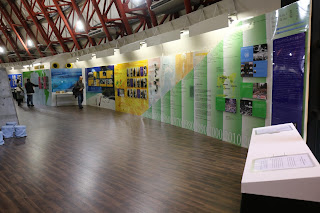Beaming a warm smile, a statue sits peacefully at a Tokyo temple as children
are playing and jumping cheerfully around in a nearby kindergarten ground on a sunny day.
 |
| Reiganji Temple's Jizo Statue |
The 2.73-meter (9-foot) bronze statue, called Jizo Bosatsu (Bodhisattva), has been there showing a graceful look for over 300 years, enduring a series of disasters.
It is one of the six bronze statues built by Jizo monk Shogen in early 1700s at the gateways to the Shogun's headquarters of Edo, according to the temple brochure. The feudalistic Edo period lasted from 1603 to 1868, when Japan's capital moved to Tokyo from Kyoto.
Wearing a hat like a lampshade and something like a red bib hanging from the
neck, the statue holds a jingling rod in the right hand and a wish-fulfilling gem, called "Hoju," in the left hand.
 |
| Reiganji Temple's Jizo Statue |
Shogen, who lived in Fukagawa that is part of Koto City now, was 24 years old when an incurable disease struck him. His selfless prayers for cure, joined by his parents, however, miraculously led to his recovery, the temple records said.
The recovery prompted him to erect six Jizo statues in a similar fashion found in Kyoto, a former capital in western Japan before the Edo period.
The monk then started soliciting funds from people and as many as 72,000 common people joined in the drive, the records stated.
It took 14 years to complete all of the six statues, commonly known as the "Edo Roku Jizo" (Six Jizo Statues of Edo), including one at the Reiganji Temple in 1717. All the names of donors and the date of their construction were inscribed on the body and the pedestals of the Jizo statues.
Having been exposed to the weather over time, almost all the original gold-plated surface of the bodies changed and some holes and cracks were found in them.
Over the past month or so, I paid a visit to each of the six temples, I could not help being impressed by a gentle look of the seated Jizo.
At the Reiganji Temple, its main hall was twice destroyed in modern times alone - by the 1923 Great Kanto Earthquake and the air raid by the U.S. forces on March 10, 1945, chief priest Ito Shinjo said, adding that the present hall was rebuilt in 1981. There is a kindergarten on the right along the approach to the temple's main building.
 |
| Reiganji Temple's Mail Hall |
In Fukagawa, there was another statue erected by Shogen at a separate temple originally, but that one was pulled down with its structure partly due to an order of a new government in 1868 under the policy of separation between Buddhism and Shintoism, temple officials say.
The remaining five of the Jizo statues were narrowly saved.
In Buddhism, Jizo Bodhisattva is considered to offer salvation to all living things in this world. Worshipping the Jizo Bosatsu gained widespread popularity among the nobles and ordinary people during the Heian period (792-1185) in Japan, according to the legend.
Buddhism came into Japan in the sixth century after passing through China. For some Japanese, without doubt, both Buddhism and Shintoism, an indigenous religion of the country, are very important in their daily lives.
The five temples where you can see the Jizo Bosatsu are as follows:
* Reiganji Temple: 1-3-32 Shirakawa, Koto City
(Get off at Kiyosumi Shirakawa, on either Tokyo Metro Hanzomon Line or Toei Oedo Line)
* Honsenji Temple: 3-5-17 Minami Shinagawa, Shinagawa City
(Aomono Yokocho on Keihin Kyuko Line)
 |
| Honsenji Temple's Jizo Statue |
* Taisoji Temple: 2-9-2 Shinjuku, Shinjuku City
(Shinjuku Gyoen Mae on Tokyo Metro Marunouchi Line)
 |
| Taisoji Temple's Jizo Statue |
* Shinshoji Temple: 3-21-21 Sugamo, Toshima City
(Sugamo on Toei Subway Mita Line)
 |
| Shinshoji Temple's Jizo Statue and Mail Hall |
* Tozenji Temple: 2-12-13 Higashi Asakuksa, Taito City
(Take the bus 'Higashi 42 Ko' in front of Tobu Asakusa Station, and get off at Higashi Asakusa)
 |
| Tozenji Temple's Jizo Statue |
By Kozo
Copyright © Koto English-speaking Volunteer Guide Association - All Rights Reserved.
 We will have a special free tour to join the Bon-odori dance event in the evening of August 25th, Sunday
We will have a special free tour to join the Bon-odori dance event in the evening of August 25th, Sunday















































